IMT变速器技术培训资料Ⅰ
- 格式:pdf
- 大小:5.85 MB
- 文档页数:37

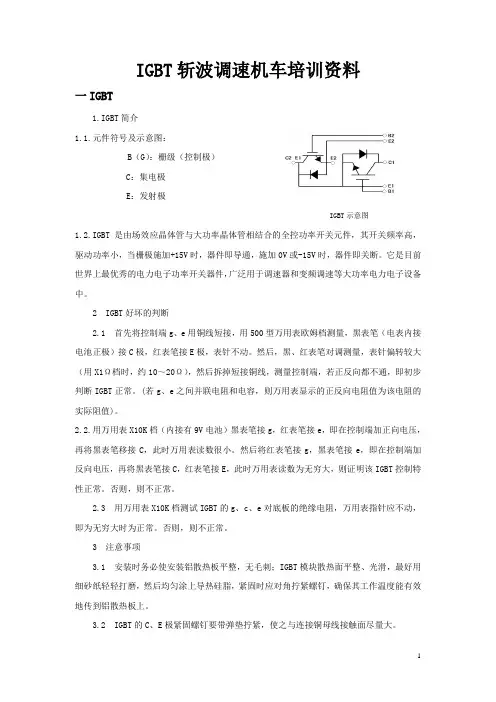
IGBT斩波调速机车培训资料一IGBT1.IGBT简介1.1.元件符号及示意图:B(G):栅级(控制极)C:集电极E:发射极IGBT示意图1.2.IGBT是由场效应晶体管与大功率晶体管相结合的全控功率开关元件,其开关频率高,驱动功率小,当栅极施加+15V时,器件即导通,施加0V或-15V时,器件即关断。
它是目前世界上最优秀的电力电子功率开关器件,广泛用于调速器和变频调速等大功率电力电子设备中。
2 IGBT好坏的判断2.1 首先将控制端g、e用铜线短接,用500型万用表欧姆档测量,黑表笔(电表内接电池正极)接C极,红表笔接E极,表针不动。
然后,黑、红表笔对调测量,表针偏转较大(用X1Ω档时,约10~20Ω),然后拆掉短接铜线,测量控制端,若正反向都不通,即初步判断IGBT正常。
(若g、e之间并联电阻和电容,则万用表显示的正反向电阻值为该电阻的实际阻值)。
2.2.用万用表X10K档(内接有9V电池)黑表笔接g,红表笔接e,即在控制端加正向电压,再将黑表笔移接C,此时万用表读数很小。
然后将红表笔接g,黑表笔接e,即在控制端加反向电压,再将黑表笔接C,红表笔接E,此时万用表读数为无穷大,则证明该IGBT控制特性正常。
否则,则不正常。
2.3 用万用表X10K档测试IGBT的g、c、e对底板的绝缘电阻,万用表指针应不动,即为无穷大时为正常。
否则,则不正常。
3 注意事项3.1 安装时务必使安装铝散热板平整,无毛刺;IGBT模块散热面平整、光滑,最好用细砂纸轻轻打磨,然后均匀涂上导热硅脂,紧固时应对角拧紧螺钉,确保其工作温度能有效地传到铝散热板上。
3.2 IGBT的C、E极紧固螺钉要带弹垫拧紧,使之与连接铜母线接触面尽量大。
3.3 IGBT驱动线出厂时均已连接好,请不要随意改动,g、e之间并联电阻应保持完好,固定螺丝应上胶,否则,IGBT通电时极易损坏。
3.4 更换IGBT时,应判断控制驱动盒是否正常,当控制驱动盒损坏,CN5、CN6始终输出高电平时,将继续损坏IGBT。
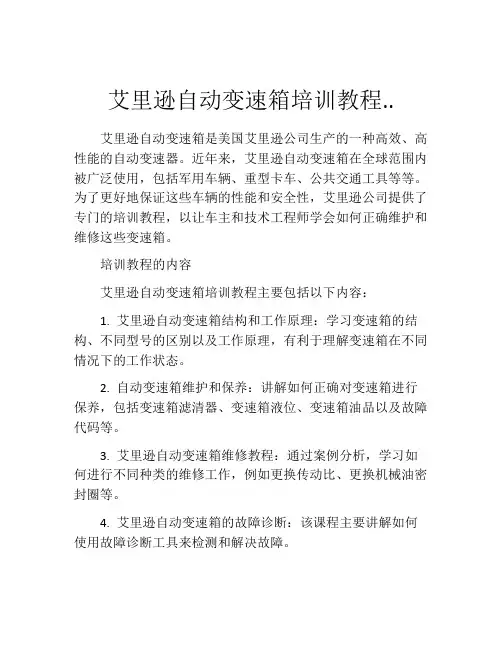
艾里逊自动变速箱培训教程..艾里逊自动变速箱是美国艾里逊公司生产的一种高效、高性能的自动变速器。
近年来,艾里逊自动变速箱在全球范围内被广泛使用,包括军用车辆、重型卡车、公共交通工具等等。
为了更好地保证这些车辆的性能和安全性,艾里逊公司提供了专门的培训教程,以让车主和技术工程师学会如何正确维护和维修这些变速箱。
培训教程的内容艾里逊自动变速箱培训教程主要包括以下内容:1. 艾里逊自动变速箱结构和工作原理:学习变速箱的结构、不同型号的区别以及工作原理,有利于理解变速箱在不同情况下的工作状态。
2. 自动变速箱维护和保养:讲解如何正确对变速箱进行保养,包括变速箱滤清器、变速箱液位、变速箱油品以及故障代码等。
3. 艾里逊自动变速箱维修教程:通过案例分析,学习如何进行不同种类的维修工作,例如更换传动比、更换机械油密封圈等。
4. 艾里逊自动变速箱的故障诊断:该课程主要讲解如何使用故障诊断工具来检测和解决故障。
以上四部分是艾里逊自动变速箱培训教程的主要内容,通过这些课程的学习,车主和技术工程师可以掌握艾里逊自动变速箱的操作技能和维护技能,提高车辆的安全性和性能。
教育资源艾里逊公司为车主和技术工程师提供了丰富的教育资源,并不断更新和改进。
这些教育资源包括:1. 在线视频教程:艾里逊公司为客户提供了一系列在线视频教程,包括基础知识、维护和保养、故障排除和维修等。
车主和技术工程师可以通过艾里逊公司的官网或其他渠道随时观看这些视频,学习相关知识。
2. 标准化培训课程:艾里逊公司为技术工程师提供了标准化的培训课程,包括在线课程和面授课程,用以培养技术工程师的专业技能。
3. 电话支持和实地支持:对于一些复杂的维修工作,艾里逊公司可以提供电话或实地支持,确保车主和技术工程师对变速箱进行正确的维护和维修。
艾里逊自动变速箱培训教程的价值艾里逊自动变速箱培训教程对车主和技术工程师有很大的价值:1. 提高车辆安全性:通过学习如何正确维护和维修艾里逊自动变速箱,可以降低车辆发生事故的概率。
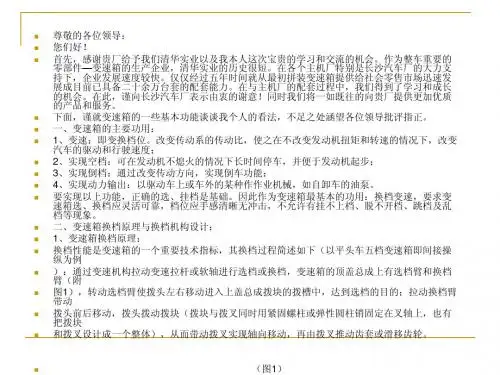
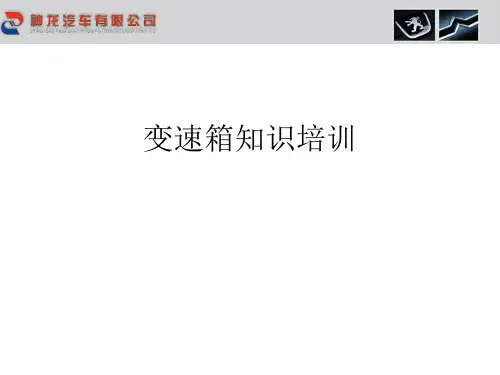
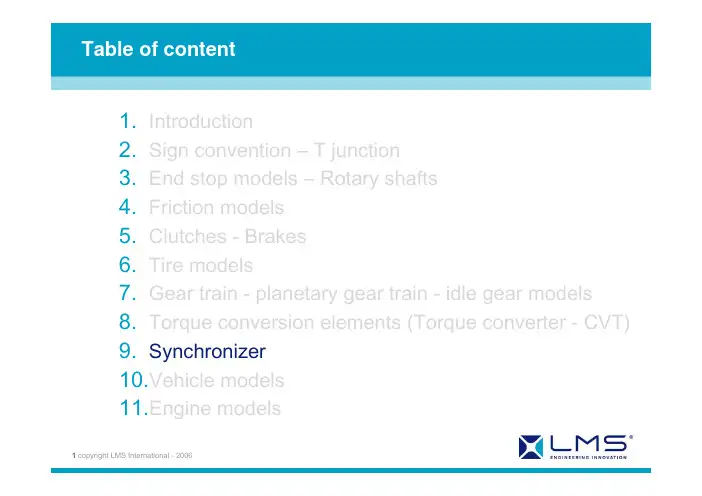
Table of content1.Introduction2.Sign convention –T junction3.End stop models –Rotary shafts4.Friction models5.Clutches -Brakes6.Tire models7.Gear train -planetary gear train -idle gear models8.Torque conversion elements (Torque converter -CVT)9.Synchronizer10.Vehicle models11.Engine modelsCONTENTS9Icons and components9The different phases during synchronization9Level 0 model9Basic elements approach for synchronization–strut component–chamfer to chamfer model9Half synchronizer using the basic element approach 9Fork model in connection to the synchronizer9 A model for gear shifting system¾Synchronizer model brings together the classical phases :9Dead zone compensation9Strut detent load build up9Blocker ring moves to indexed position9Cone clutch energized by sleeve chamferscontacting ring chamfers9Rings moves aside to pass sleeve splines9Gear moves aside to pass sleeve splines tocomplete lock upStage 1: Neutral position to strut detent positionStage 2: Strut detent load build-upStage 3: Index positionStage 4: Chamfer-to-chamfer loading, pre-synchronizationStage 5: Blocker ring indexed9theoretical equality of rotary velocityStage 6: Free flying9sleeve blocked by idle gear9final lock-upSynchronizer: the different phasesThe cone/cone frictionThe strut function modelThe strut function model parametersThe strut function model resultsstrut_model.ameThe half synchronizer model: Simple model⎟⎠⎞⎜⎝⎛×=dV Vrel F F dyn frot 2tanh withαμsin cmd dyn moy dyn dyn F R T F ×==Level 0 function9The synchronizer is close to a clutch function Îfriction model only9Saturated slope model for the frictionHalf synchronizer –Level 0 model parametersAlternatives to the Simple Half Synchronizer Model ¾Other half synchronizer models:9Difficult to build a model with a global approach9Use basic element approach:ÎCompromise to be found betweenless generic /too specificortoo generic /less comprehensiveÎGeneric decomposition into basic elementsturns out to be necessary : sleeve / ring and sleeve/ gear contacts need a separate analysisDog-to-dog contact modelIt normally corresponds to:9Index position (due to external end stops)9Chamfer to chamfer loading and pre synchronization 9Sleeve and ring are indexed9Free flying (no more load is applied) successively.Only one submodelavailable.BUT corresponds to several modeling assumptions concerning :-Teeth geometry-Friction computationModeling complexity to be chosen by pop-up menus directly in the Parameter ModeSimple = symmetricalComplex = asymmetricalWith or without back angle(negative angle ensuringfinal lockup betweensleeve and idle gear )Friction between dogs can be considered with a tanh frictionmodel()B B y x U B A l 2sin 2cos 111αα+−=⋅=⊥v v v 2cos 2sin 2cos 222αααe y x U B A l B B −−=⋅=⊥r v vA 1α BA 2y x(D 2)(D 1) (D 2⊥)(D 1⊥) Blocker ring Sleeve Rotary motionCalculation of the dogs contact pointsie : symmetrical dogs withno back angle nor frictionie : asymmetrical dogs withback angle and frictionBasic calculations for hidden parameters:9Effective radius for the contact :9All the contacts along the sleeve circumference are supposed to be identical. Hence the computations are performed in an interval whose length is :9Due to the chosen frame origin, the interval limits are :dogdog N tgclear w R +⋅=.221dogN Inter 360=⎥⎦⎤⎢⎣⎡+−tgclear R w R w dog dog .2.3;.2How can we use this component ?ÎA simple example to start to understand how it works:test_indexation.ameResultsThe Complex Half Synchronizer ModelLoad the AMESim demofile test_synchro.ameThe two inputs on the synchronizerz Sleeve displacement for 2 important times during the synchronizationIt is also possible to model the complete system of gear shifting process: from the driver to the synchronizer.First element to model the fork and the ball system.the parameter values.test_fork.ameslop anglemain diameter bottom of slot The reference must be the same for all dimensionsNEUTRALGEAR ENGAGED main diametertop of slot main diameterbottom of slot slopangle radiuslength parameter settings.The fork simulation results should be compared to a more sophisticated resultincluding all the static effects.To do so the fork control element, the cable and the gear lever should be modeled.This is done when theselection of the right forkand the gear change partsare decoupled from amechanical point of view(which is the case most ofthe time )for car park maneuvers (the synchronizer meshing is aligned)When this has been done, an analysis of the synchronization can be carried out on road to test clash or nibble phenomena and quality of the gear shifting.New AMESim Rev7 Feature•Example of a Shift analysis in a Manual Transmission new designDetailed model ofsynchronizer for gearshift optimization。

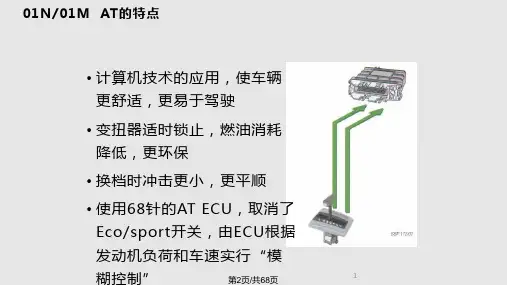



变速箱培训资料变速箱是汽车传动系统中至关重要的一部分,它通过不同的齿轮组合来改变发动机输出的转速和扭矩,使车辆能够在不同速度下平稳加速或保持稳定的行驶状态。
对于汽车修理工或汽车爱好者来说,了解和掌握变速箱的工作原理和维护方法是非常重要的。
本文将为您介绍变速箱的基本知识和常见故障排除技巧。
第一篇:变速箱的基本原理和工作过程变速箱是将发动机的动力传递到车轮上的重要部件,它通过齿轮组合的方式改变发动机的输出转速和扭矩。
现代汽车通常采用手动变速箱或自动变速箱,每种变速箱都有其特定的工作原理。
手动变速箱的工作原理是通过驾驶员操作离合器和换挡杆来改变齿轮的组合,进而改变发动机输出的转速和扭矩。
当驾驶员踩下离合器踏板时,变速箱输入轴与发动机的动力断开,此时可以自由切换挡位。
当离合器踏板释放时,发动机动力再次传递到变速箱,根据挡位的不同,电动机的转速和扭矩将以不同的比例通过齿轮组合传递到车轮上。
自动变速箱与手动变速箱的工作原理有所不同。
自动变速箱通过液压控制和电子控制单元来自动切换齿轮组合,驾驶员只需要选择驾驶模式(如D、R、N)即可。
自动变速箱内部有许多离合器和制动器,通过调整液压压力来实现齿轮的切换,以满足不同车速和行驶条件下的需求。
自动变速箱通常具有多个驾驶模式,如经济模式、运动模式和雪地模式,以提供最佳的行驶性能和燃油经济性。
无论是手动变速箱还是自动变速箱,其工作过程中都会产生摩擦、磨损和热量。
因此,定期维护和更换变速箱油是保持变速箱正常运行的重要步骤。
变速箱油起到润滑和冷却的作用,可以减少齿轮组件之间的摩擦和磨损,并帮助散发产生的热量。
同时,定期更换变速箱油可以防止油品老化和污染,保持变速箱的正常工作和延长使用寿命。
除了定期维护和更换变速箱油,及时发现和解决变速箱故障也是非常重要的。
常见的变速箱故障包括漏油、异响、挂档困难和换挡顿挫等。
当发现变速箱故障时,应及时将车辆送修,并由专业技术人员进行检查和维修。